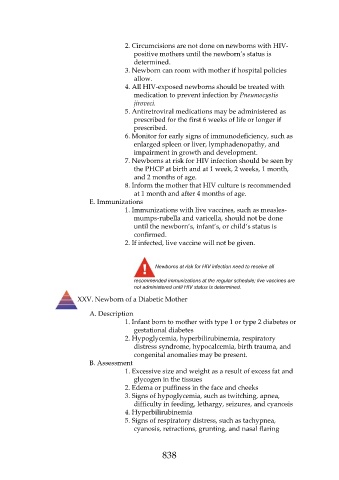Page 838 - Saunders Comprehensive Review For NCLEX-RN
P. 838
2. Circumcisions are not done on newborns with HIV-
positive mothers until the newborn’s status is
determined.
3. Newborn can room with mother if hospital policies
allow.
4. All HIV-exposed newborns should be treated with
medication to prevent infection by Pneumocystis
jiroveci.
5. Antiretroviral medications may be administered as
prescribed for the first 6 weeks of life or longer if
prescribed.
6. Monitor for early signs of immunodeficiency, such as
enlarged spleen or liver, lymphadenopathy, and
impairment in growth and development.
7. Newborns at risk for HIV infection should be seen by
the PHCP at birth and at 1 week, 2 weeks, 1 month,
and 2 months of age.
8. Inform the mother that HIV culture is recommended
at 1 month and after 4 months of age.
E. Immunizations
1. Immunizations with live vaccines, such as measles-
mumps-rubella and varicella, should not be done
until the newborn’s, infant’s, or child’s status is
confirmed.
2. If infected, live vaccine will not be given.
Newborns at risk for HIV infection need to receive all
recommended immunizations at the regular schedule; live vaccines are
not administered until HIV status is determined.
XXV. Newborn of a Diabetic Mother
A. Description
1. Infant born to mother with type 1 or type 2 diabetes or
gestational diabetes
2. Hypoglycemia, hyperbilirubinemia, respiratory
distress syndrome, hypocalcemia, birth trauma, and
congenital anomalies may be present.
B. Assessment
1. Excessive size and weight as a result of excess fat and
glycogen in the tissues
2. Edema or puffiness in the face and cheeks
3. Signs of hypoglycemia, such as twitching, apnea,
difficulty in feeding, lethargy, seizures, and cyanosis
4. Hyperbilirubinemia
5. Signs of respiratory distress, such as tachypnea,
cyanosis, retractions, grunting, and nasal flaring
838

